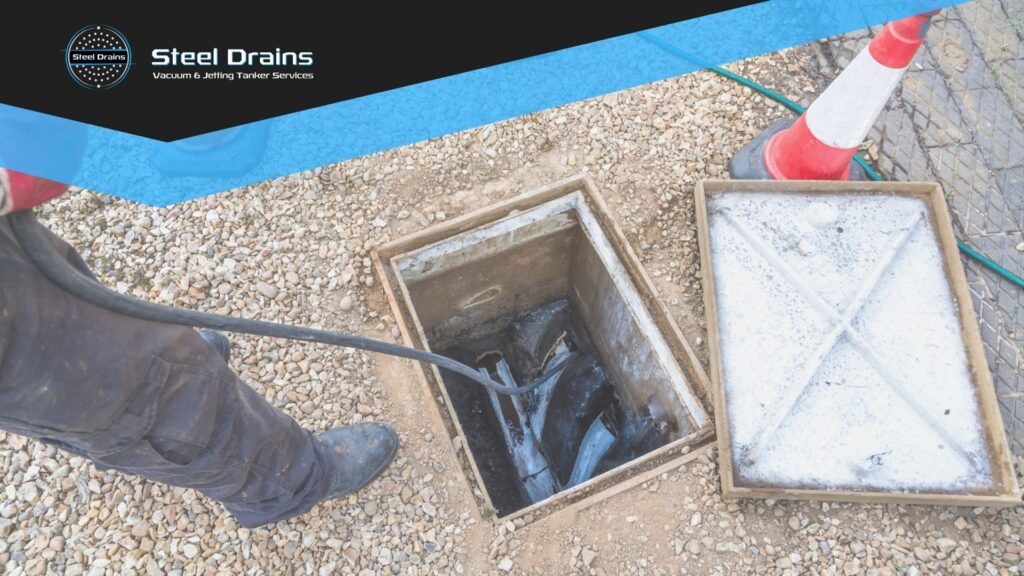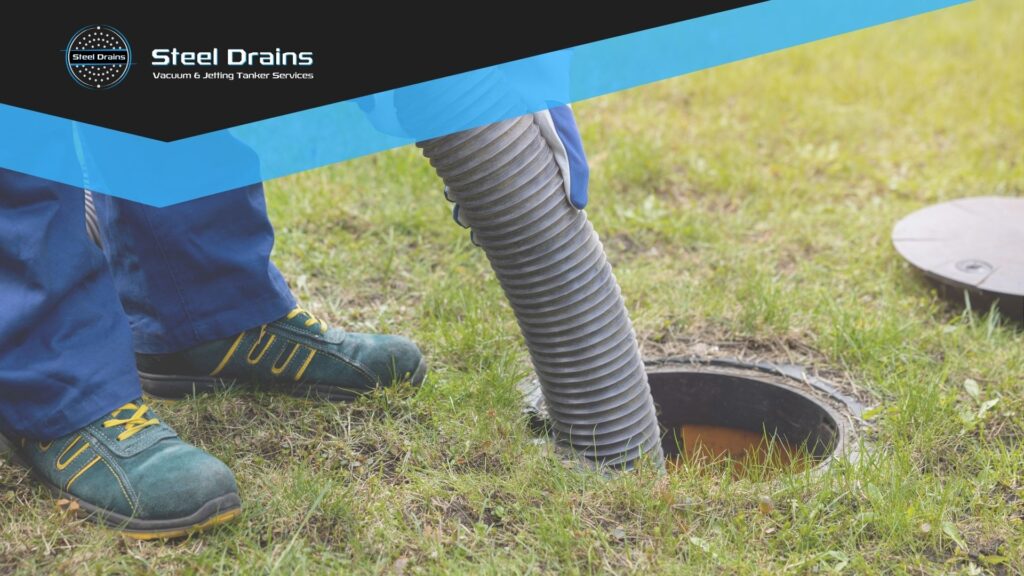Introduction
Effective drain maintenance is critical for property management, often overlooked until a major issue arises. Property owners, facility managers, and maintenance professionals must understand the significance of maintaining drainage systems to avoid costly and disruptive problems such as flooding, sewage backups, and structural damage. Common drainage issues stem from various causes, including tree root intrusion, debris accumulation, grease build-up, and sedimentation.
To tackle these challenges, two primary techniques have become essential: drain jetting and drain vacuuming. While both methods aim to ensure the smooth operation of drainage systems, understanding their distinct applications and benefits is crucial for anyone responsible for property upkeep. This blog post will explore the nuances of drain maintenance, highlighting the complementary roles of drain jetting and vacuuming, and offering insights on how to implement these techniques effectively.

Understanding Drain Maintenance
Drain maintenance involves practices aimed at ensuring drainage systems function optimally. Several factors contribute to blockages, including:
- Tree Roots: Roots can infiltrate underground pipes, causing significant blockages and damage.
- Debris Accumulation: Leaves, dirt, and other debris can clog drains and hinder water flow.
- Grease Build-Up: Fats, oils, and grease can accumulate over time, leading to severe blockages.
- Sedimentation: Sediment can settle within pipes, causing reduced flow and blockages.
Regular drain maintenance is essential. By proactively addressing these issues, property owners can prolong the lifespan of their drainage systems and avoid the costly repairs associated with emergencies. Neglecting maintenance can lead to severe consequences, such as:
- Flooding: Blocked drains can cause water to back up, leading to flooding and water damage within properties.
- Structural Damage: Prolonged water exposure can weaken a building’s foundation and structural integrity.
- Health Hazards: Stagnant water can become a breeding ground for harmful bacteria and pests, posing health risks to occupants.
The key takeaway is that regular drain maintenance is an investment in the longevity and functionality of drainage systems.
What is Drain Jetting?
Drain jetting is a method that uses high-pressure water jets to remove blockages and clean the internal surfaces of drainage pipes. This technique employs high-pressure water jetting machines equipped with specialised nozzles that can deliver water at pressures often exceeding 4000 psi.
The process works as follows:
- Inspection: Before jetting, professionals typically inspect the drainage system using CCTV cameras to identify the nature and location of the blockage.
- Preparation: The appropriate equipment is assembled, and the jetting hose is inserted into the drainage system.
- Execution: The machine is activated, sending powerful jets of water into the pipes. This force dislodges blockages caused by grease, debris, and other materials while cleaning the pipe walls.
- Follow-Up: After the jetting process, a follow-up inspection is often conducted to ensure that the blockage has been effectively removed.
Benefits of Drain Jetting
- Effective Blockage Removal: High-pressure water jetting is highly effective at clearing stubborn blockages that traditional methods may not address.
- Thorough Cleaning: Jetting not only removes blockages but also cleans the internal surfaces of pipes, preventing future build-up.
- Preventive Maintenance: Regular jetting can form part of a preventive maintenance routine, helping to eliminate potential blockages before they escalate.
- Versatility: Drain jetting can be employed across various types of drainage systems, including residential, commercial, and industrial applications.
What is Drain Vacuuming?
Drain vacuuming involves using specialised equipment, such as vacuum trucks or portable vacuum units, to extract debris, liquids, and sludge from drainage systems. This method is particularly useful for clearing out accumulated waste from drains that cannot be effectively addressed through jetting alone.
The vacuuming process typically includes:
- Assessment: Similar to jetting, a comprehensive assessment of the drainage system is conducted to identify areas that require vacuuming.
- Preparation: The vacuum unit is positioned, and hoses are connected to the drainage system.
- Extraction: The vacuum system creates suction, removing various materials, including silt, mud, sludge, and other solid waste.
- Disposal: The extracted materials are transported to a designated waste disposal site, ensuring proper environmental handling.
Benefits of Drain Vacuuming
- Efficient Waste Removal: Vacuuming is highly efficient, capable of quickly removing large quantities of wet waste and sludge.
- Prevention of Overflows: By extracting accumulated waste, vacuuming helps prevent overflows and backups that can lead to more significant problems.
- Environmental Compliance: Proper vacuuming and disposal of waste ensure compliance with environmental regulations regarding waste management.
- Versatile Applications: Drain vacuuming is applicable for various tasks, including septic tank cleaning, wet well cleaning, and stormwater management.
Comparing Drain Jetting and Vacuuming
To determine the most effective method for a given situation, it is essential to compare the strengths and applications of drain jetting and drain vacuuming.
Drain Jetting:
Strengths:
- Ideal for clearing stubborn blockages caused by grease, scale, or debris.
- Cleans pipe walls and prevents future blockages.
- Versatile and applicable to various drainage types.
Best Applications:
- Situations where blockages are caused by solid objects or build-up.
- Preventive maintenance routines to clean and maintain drainage systems.
Drain Vacuuming:
Strengths:
- Highly effective in removing wet waste, sludge, and debris.
- Prevents overflows and backups by clearing accumulated waste.
- Ensures environmental compliance through proper waste disposal.
Best Applications:
- Situations where liquid waste or sludge needs to be extracted.
- Post-jetting clean-up to remove any residual waste.
The Importance of Regular Drain Maintenance
Regular drain maintenance is vital in preventing emergencies and costly repairs. Implementing a routine maintenance schedule that incorporates both drain jetting and vacuuming can significantly enhance the performance and longevity of drainage systems.
Best Practices for Drain Maintenance:
- Routine Inspections: Conduct regular inspections to identify potential issues before they escalate.
- Scheduled Cleaning: Establish a cleaning schedule that includes both jetting and vacuuming, tailored to the specific needs of the drainage system.
- Professional Assessments: Engage with drain maintenance professionals who can provide expert assessments and recommendations.
- Educating Occupants: Inform building occupants about proper waste disposal practices to reduce the likelihood of blockages.

Conclusion
In conclusion, understanding the unique advantages of both drain jetting and drain vacuuming is essential for effective drain maintenance. When used together, these techniques can significantly enhance the efficiency and longevity of drainage systems. By adopting a proactive approach to drain care, property owners, facility managers, and maintenance professionals can prevent costly repairs and ensure that drainage systems remain functional and efficient. Incorporating both methods into a comprehensive maintenance strategy is not just advisable; it is a necessity for anyone responsible for maintaining property drainage systems. Start prioritising your drain maintenance today to safeguard against future issues and ensure the optimal performance of your drainage systems.